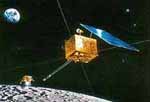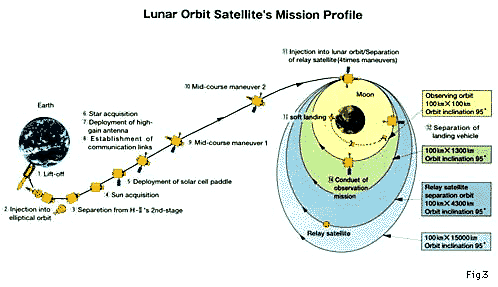 Tokyo - April 3, 1997 - The SELENE Project is being promoted to implement Japan's exploration of the Moon in 2003 using a lunar orbit satellite and a lunar landing experiment vehicle. These should prove successful in fulfilling the project's mission by operating a variety of on-board instruments.
Tokyo - April 3, 1997 - The SELENE Project is being promoted to implement Japan's exploration of the Moon in 2003 using a lunar orbit satellite and a lunar landing experiment vehicle. These should prove successful in fulfilling the project's mission by operating a variety of on-board instruments.
The most dramatic activity in the history of the relationship between the human race and the Moon is probably the Apollo Project, which sent humankind to the Lunar surface for the first time in July 1969. This project was completed at the end of 1972 after obtaining much precious scientific data on the Moon. The Project also revealed a variety of new mysteries there.
Twenty five years have elapsed since completion of the Apollo Project, and scientists worldwide now eagerly anticipate return to the Moon to investigate mysteries concerning its origin and evolution which would provide them with important keys for research on the Earth and other planets.
The Moon is also a potential source of space resources. In Japan, the foundation for conducting lunar exploration is being built, as demonstrated in the Lunar-A and SELENE projects. Japan plans to undertake this mission of lunar exploration to challenge the mysteries over the origin and formation of the Moon, and contribute to the world's effort to build a basis for lunar exploitation. Hence, the SELENE mission is extremely meaningful both for Japan and the international community as a whole.
Outline of SELENE Project
The SELENE (SELenological and ENgineering Explorer, project is to launch Japan's first lunar probe by a H-IIA rocket around 2003. It is a joint project between the National Space Development Agency of Japan (NASDA) and The Institute of Space and Astronautical Science (ISAS). Its objectives include collecting data necessary to elucidate the origin and evolution of the Moon, and developing the technology for soft landing on the Moon which is vital for lunar exploration. The acquired data will also used for research on the potential of future utilization of the lunar environment. SELENE is an explorer consisting of a lunar orbit satellite, a Moon-landing experiment vehicle and a relay satellite.
 SELENE is planned to approach the Moon about 5 days after lift-off. After being injected into an elliptical orbit, the lunar orbit satellite lowers its apogee step by step, finally placing itself in a circular polar orbit at the lunar altitude of 100 kilometers. During this flight, the relay satellite is injected into an elliptical orbit at an apogee of 4,300kilometers, and relays ranging signals between the Earth station and the lunar orbit satellite to measure the gravitational field of the Moon's back side. The orbiting satellite will operate for one year to map the whole Moon surface.
SELENE is planned to approach the Moon about 5 days after lift-off. After being injected into an elliptical orbit, the lunar orbit satellite lowers its apogee step by step, finally placing itself in a circular polar orbit at the lunar altitude of 100 kilometers. During this flight, the relay satellite is injected into an elliptical orbit at an apogee of 4,300kilometers, and relays ranging signals between the Earth station and the lunar orbit satellite to measure the gravitational field of the Moon's back side. The orbiting satellite will operate for one year to map the whole Moon surface.
The lunar landing experiment vehicle separates from the orbiting satellite after reaching the predetermined circular polar orbit. The vehicle is commissioned to verify the technology of lunar soft landing. After landing on the Moon, it transmits radio signals for observation by Very Long Baseline Interferometer (VLBI).
On-board Instruments under Consideration
Currently considered on-board instrument consolidates for studying the composition of the elements and minerals in the lunar surface layers include a fluorescent X-ray spectrometer, gamma ray spectrometer, multi-band imager, and spectrum profiler. A topographic camera, altimeter and radar sounder are considered as instruments for investigating the tectonics of the Moon by probing into the lunar topography and the underground structure of the Moon surface. The onboard instruments are also planned to include those for examining the gravitational field using the source of radio signals and the relay satellite; mapping the magnetic anomalies of the Moon with the magnetometer's data; and measuring the environmental conditions of the magnetosphere between the Moon and the Earth using a plasma imager. To monitor the lunar environment instruments, such as a dust analyzer, particle beam measurement unit and plasma observation device are also considered for adoption as on-board instruments.
Related Links
SpaceDaily
Search SpaceDaily
Subscribe To SpaceDaily Express
![]()
SPACE.WIRE |